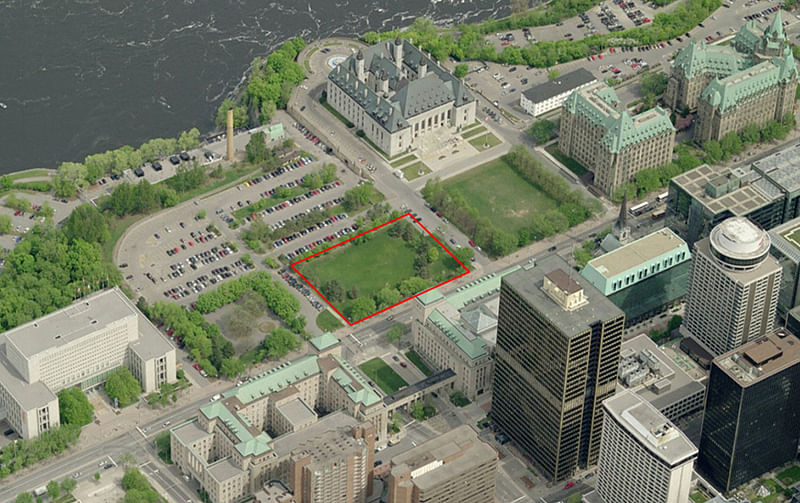The winning design of Canada's National Memorial to Victims of Communism
By Bustler Editors|
Thursday, Dec 11, 2014

Related
ABSTRAKT Studio Architecture was chosen to design Canada's future National Memorial to Victims of Communism in Ottawa, the nation's capital. The winning team -- architect Voytek Gorczynski (Toronto), artist Janusz Kapusta (New York), and architect Andrzej Pawlik (Warsaw) -- was selected out of six finalists at the end of the two-phase national competition held this summer.
The memorial will pay tribute to the more than 100 million people around the globe who suffered or perished under communist dictatorship, as well as educate the public about the heavy consequences caused by communism. As a national memorial, it will also signify Canada's role in offering refuge to those who escaped that oppression. It will be located on Confederation Boulevard beside the Supreme Court of Canada, the Library and Archives Canada, the Peace Tower, and other key federal institutions.
The main monument elements are scheduled for official inauguration in fall 2015.
Earlier this year, the Canadian Government also selected a design for their National Holocaust Monument competition. The winning team included architect Daniel Libeskind.
Read more about the winning design below.
Shortened version of ABSTRAKT Studio Architecture's project description:
"...The fundamental premise and guiding light for the project was how to evocatively honor and commemorate 100 million victims of the communist regimes throughout the world while anchoring it firmly in the Canadian collective consciousness. We set out to visualize the inconceivable extent of the heinous communist crimes by trying to materialize this unimaginably large number in order to honor and commemorate each of the lives cut short in the name of this utopian ideology.
Primitive societies in the past were able to count to just four - anything exceeding this number was described as the 'many'. To see is to comprehend. To see and touch is to understand, and get frightened by this paralyzing 'many'. This assertion informs our project, since 100 million just written down or mentioned in passing is an abstraction that makes us helpless and therefore indifferent. As the most prolific communist murderer Joseph Stalin famously said: 'One death is a tragedy; one million is a statistic'."

"This 'statistic' takes main stage in our design by realizing its sheer enormity, thus raising awareness that every human life is unique and precious. If we were to dedicate 1cm2 (digit or finger – ancient measurement of length) of memory to each life lost because of communism then 1m2 would memorialize 10,000 lost lives. A cemetery laid out on the 100mx100m square would symbolize the 100 million lost lives and would help one to visualize and comprehend these communist crimes.
This resultant 'document' of 'many' containing 100 million memory squares would have to be compressed to fit on our site – folded and transformed into a concrete triangle to give it a permanent.The emergent folded triangular plane would contain 1m wide contemplative paths enabling a visitor direct contact with the 100 million singular pixel-like memory squares covering exterior face of folds. Each represents an individual lost life. To make the memory squares more tactile they have been designed in the form of a three-dimensional truncated pyramid with the square the size of a small human fingertip on top...
While concrete folds invoke the Past, the central plaza is very much entrenched in the Present. It constitutes the axis of time, the space for gatherings during memorial events and anniversaries as well as for communities commemorating their suffering under communism or protesting the ongoing suffering of those still living under communist rule. The focal point of the plaza is a lone, life-size memory square with the concrete cast of the unknown victim lying face down. The unknown victim establishes a direct visual connection with the 100 million memory squares covering the folded document of 'many' behind it."

"...The concrete folds establish the ambiance to contemplate the Past and sequentially the Memorial Plaza’s open space signifies the Present. The Bridge of Hope with viewing platform on top of stairs delineates the Plaza on the east and constitutes the Future.
In addition, 1000 names of victims of communism who found refuge on Canadian soil will be located also at the bottom of these stairs on a vertical wall facing the main plaza. This route of Hope and Gratitude is to remind visitors of the role Canada played throughout its history as a refuge for many victims suffering oppression under communist regimes around the world.
From Wellington Street walking west along the Confederation Boulevard, the Memorial will be perceived as a solemnly rising modern concrete sculpture, 9m high at the highest point...The Memorial is designed tectonically as a cast-in-place, exposed, reinforced, architectural self-cleaning concrete structure."

Share
0 Comments
Comment as :